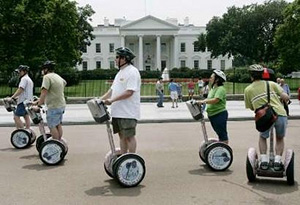 |
 |
 |
 Technology News | August 2006 Technology News | August 2006  
Segway Launches 2 New Scooters
 Michael P. Regan - Associated Press Michael P. Regan - Associated Press


| | Tourists ride Segway personal transporters in front of the White House during a sightseeing tour of Washington. The maker of the Segway scooter on August 14, 2006 unveiled the second generation of its self-balancing electric one-person vehicle. (Reuters/Jason Reed) |
Riding on the new version of Segway Inc.'s self-balancing electric scooter is "very similar to skiing," according to the company's chief technology officer.

That's because a new batch of technology in the second generation of the Segway allows users to steer the device simply by leaning in the direction they want to go, rather than using a handlebar, said Segway Chief Technology Officer Doug Field.

The new version of the Segway Personal Transporter also comes with a wireless device that lets the user start it by remote control and receive an alert if it has been disturbed while left unattended.

It also has a sleeker, more futuristic design than its predecessor, and a starting retail price of $4,995. A more rugged version meant for off-road use has a starting price of $5,495.

The company has stopped producing the older models but will continue to offer customer support to owners of older Segways.

Segway wanted to make the new version of the scooter more intuitive and fun to ride, a vehicle that "truly becomes an extension of your body," according to Field.

"The best interface is no interface at all," he said.

Like the original version, the rider still stands on a platform between two wheels and holds onto a handlebar supported by a stem that rises vertically from the base. But all of the electronics and wires have been removed from the top part of the machine.

The key to the new steering technology, Field said, is at the pivot point between the stem and the base, where a group of sensors "reads your body angle" and communicates the information to the software that controls what direction it travels.

The other major update is a wireless controller called the InfoKey which has four buttons and an LCD screen and looks like a large digital watch. It's used to turn the scooter on, but also serves as "trip computer" with such functions as an odometer, speedometer and battery gauge.

It also can be used to activate an anti-theft alarm for when an owner leaves the device unattended. If the device is disturbed while the anti-theft feature is activated, the Segway locks up, sounds an alarm and sends a notice to its owner over the InfoKey.

Field said there has not been widespread problems with Segway thefts, but the device is such a target of curiosity that many users experience anxiety when they leave it unattended in public, even if only for a few minutes to run into a store.

Since its launch in 2001, the Segway has been widely praised for the sophisticated software engineering that allows a rider to balance effortlessly on two wheels. But its persistently high price often is cited as one of the reasons it has not yet lived up to the predictions of its inventor and backers that it would revolutionize personal transportation.

It is also sometimes mocked as the ultimate in tech geekiness. CNet Network Inc.'s technology Web site News.com put the nascent sport of Segway polo at the top of its list of the 10 worst technologies in the second quarter of 2006.

Still, the Segway has attracted an avid group of hardcore users who cherish their time "gliding" on the device. It's also found niche markets around the world among police and security departments whose officers who use it to patrol a beat, and entrepreneurs who rent Segways out or lead tour groups of gliders.

The next-generation of Segway comes in two models, the i2 and the x2. The x2 is meant for more rugged terrain. Both have a top speed of 12.5 mph. The i2 can glide for up to 24 miles on a single battery charge, while the x2 can go 12 miles.

By the end of the year, the company plans to have six packages of the next-generation Segway available, including one meant for use as a one-person golf cart and others tailored for commuters, police and to haul cargo in commercial applications.

The company has kept details about its financial health a secret. President and Chief Executive James Norrod told The Associated Press in May that "tens of thousands" of Segways have been sold around the world, and that the company's revenue has been growing by at least 50 percent over each of the last few years.

Norrod has made one of his top priorities as CEO to groom the company for an initial public offering or other liquidity event within the next few years.

On the Net: http://www.segway.com | 
 | |
 |



